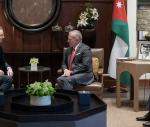You are here
Rebooting nuclear security
Dec 08,2014 - Last updated at Dec 08,2014
In these days of economic woe, potential pandemic disease and widespread civil unrest, it may come as a surprise that so many people around the world still view nuclear conflict as the greatest threat facing humanity.
They do so with good reason. Consider the potential effects of a 50-megatonne nuclear explosion, similar to the Tsar Bomba, detonated in October 1961, which shattered windows 900 kilometres away and sent a mushroom cloud rising above the stratosphere.
Global agreements such as the Nuclear Non-Proliferation Treaty (NPT), along with the general sense of goodwill immediately following the Cold War, may have led to the perception that such a weapon would never be used in combat.
But there is an increasing realisation that we cannot breathe easy just yet.
In considering the risks, the emphasis has shifted over the last decade from preventing additional states from acquiring nuclear weapons to preventing terrorist groups and other non-state actors from acquiring them (or critical components).
The stakes are high and the threat is real. The danger of nuclear terrorism constitutes one of the gravest threats to our
collective security.
Even a small amount of nuclear material could kill and injure hundreds of thousands of innocent people.
Terrorist networks could acquire the materials to assemble a nuclear weapon, wreaking havoc on global peace and stability, with the possibility of extraordinary loss of life and economic damage.
This has been the main focus of the biennial Nuclear Security Summit, which began in 2010 with 47 countries and three international organizations.
But the NSS has so far restricted its scope to protecting nuclear infrastructure and material from active misuse. We should be wary about defining nuclear security so narrowly.
We do not have the luxury of approaching the linked issues of arms control, disarmament and non-proliferation separately.
In today’s highly complex, interconnected world, we must consider all nuclear threats in a holistic way.
A good starting point is to consider how the Comprehensive Nuclear-Test-Ban Treaty is contributing to nuclear security. By banning all nuclear explosions, the CTBT hampers both first-time development of nuclear weapons and substantial improvements to them. In the last 15 years, only one country — North Korea — has tested a nuclear weapon.
And, by doing so, it has cemented its status as a rogue state.
It is clear that the NPT and the CTBT have reinforced nuclear security.
Only a handful of countries have developed nuclear weapons outside of the NPT, and the CTBT has reduced the number of nuclear tests from an average of 500 per decade to a mere trickle.
Yet the failure of eight countries to ratify the CTBT has prevented it from entering into force, and its contribution to global security has so far not been included on the NSS agenda.
Given the existence of a technologically advanced verification regime that can detect even small underground nuclear tests — what US Secretary of State John Kerry recently called “one of the great accomplishments of the modern world” — this is especially disappointing.
The international community’s failure to bring the CTBT into force is one of the reasons why the Bulletin of Atomic Scientists’ iconic Doomsday Clock remains poised at five minutes to midnight — the closest it has been to midnight since the height of the Cold War.
But, while there clearly is cause for concern, there is no reason to lose hope.
With the next Nuclear Security Summit to take place in the United States in 2016, a window of opportunity will be opened by next year’s NPT Review Conference, which will allow the world to address the issue of nuclear security in a long-term, inclusive manner.
What is most needed in the run-up to the 2016 NSS is a process that advances global action to address the nuclear threat comprehensively, including by ensuring that the CTBT enters into force.
We owe it to ourselves and to future generations to use all opportunities to create the conditions for increased trust and mutual understanding that are needed to free the world of the nuclear threat.
Broadening our understanding of that threat, and devising a comprehensive approach to nuclear security does not mean diluting efforts or losing focus.
On the contrary, it means taking care not to exclude any significant advocate or useful tool in reducing the risk of the unthinkable becoming reality.
The writer is executive secretary of the Comprehensive Nuclear-Test-Ban Treaty Organisation (CTBTO) and a member of the World Economic Forum’s Global Agenda Council on Nuclear Security 2014-2016. ©Project Syndicate, 2014. www.project-syndicate.org












